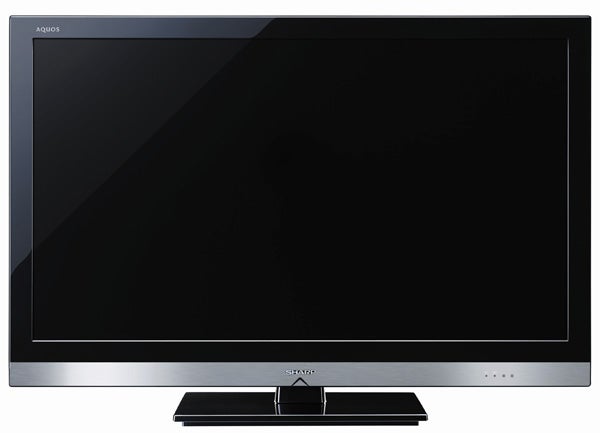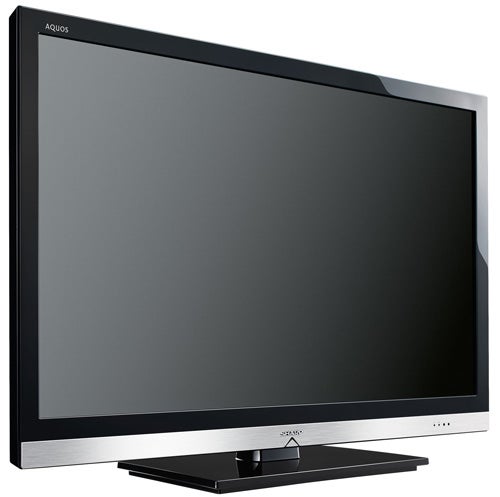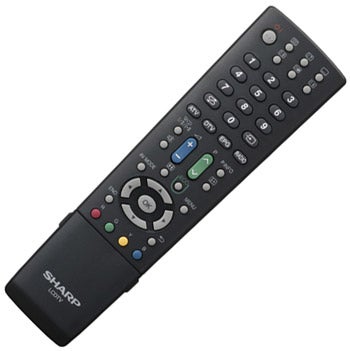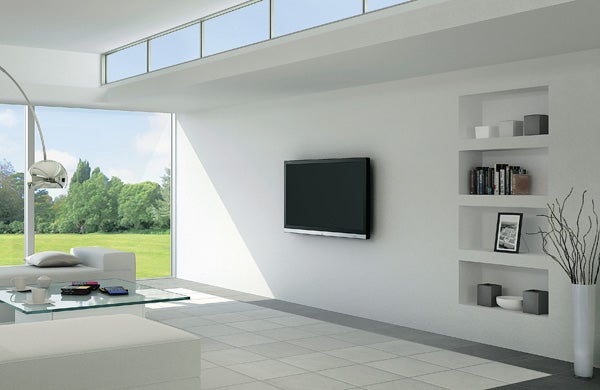Sharp Aquos LC-40LE600E 40in LED Backlit LCD TV Review
Sharp Aquos LC-40LE600E 40in LED Backlit LCD TV
The LC-40LE600E is a genuine original to the UK LCD TV market, offering direct LED lighting with white dimming for a good price.

Verdict
Key Specifications
- Review Price: £807.00
For a brand that used to be at the forefront of LCD TV technology, Sharp has been very quiet lately. Ominously so, in fact. For not only have we not seen the brand producing as many new LCD TVs as we’d expect, but even when they have had new models, review samples have been consistently impossible to get hold of, despite repeated requests.
Today, though, it’s starting to look as if Sharp’s extended silence hasn’t been, as we’d feared, an early sign of serious financial difficulties. Instead, with the arrival of the LC-40LE600E, the brand’s protracted ‘hibernation’ appears more symptomatic of a brand treading water while awaiting the arrival of a Great White Hope. Or to be more precise, a Great White Dimming LED hope…
The 40LE600E is, you see, a genuine original to the UK market, offering direct LED lighting with white dimming for an unprecedentedly cheap price. And while it might not be quite as rip-roaringly perfect and revolutionary as I might have hoped, it’s easily good enough to get Sharp well and truly back in the serious LCD TV game.
The complicated state of the burgeoning LED-backlit world means that before I proceed any further, I really need to go into a little technical background on what exactly is meant by the 40LE600E’s ‘direct LED lighting’ and ‘white dimming’ technologies.
Direct LED lighting simply means that the LED light arrays that illuminate the 40LE600E’s pictures are positioned directly behind the screen, firing straight through it, rather than being positioned around the edge of the screen as is the case with, say, Samsung’s current LED models.
This is significant because – despite Samsung’s admittedly persuasive arguments to the contrary – the direct LED approach is still widely reckoned to be the premium approach in terms of picture quality. Why? Because of the way it allows you to individually turn on or off different LED clusters, potentially allowing peak whites and pitch blacks to sit side by side on screen to produce the sort of contrast performance that standard LCD TVs can currently only dream about.
The white dimming element of the 40LE600E, meanwhile, means that the LEDs operate with pure white light output, with separate colour filters producing the image’s final colouration, rather than outputting RGB colours at the LED source as happens with LED backlit models like Sony’s X4500s and Sharp’s own XS1E range.
This is arguably a compromised approach, since RGB dimming can produce a purer and more dynamic colourscape. But the reality is that white dimming appears to produce a perfectly adequate colour range if used well. In fact, our experience is starting to suggest that by being slightly more limited in colour range than RGB dimming TVs, white-dimming models actually produce colours that mesh more comfortably with our main video standards.
At this point, it’s worth stressing that Sharp isn’t the first brand to sell a TV that combines white dimming with direct LED lighting. But critically, with its £807 price tag, the 40LE600E is miles cheaper than any of its similarly specced forerunners, finally opening the direct LED door to a mainstream audience.
Sharp has sensibly decided to shout about the technological shift it’s making with the 40LE600E by giving it a rather swish new black and silver design.
I was a little concerned, perhaps, by how light the TV felt as I set it on its stand; it certainly feels as if a fair bit of cheap and cheerful plastic has gone into its chassis. But I guess the striking lightness of the TV at least makes it less demanding on your wall if you’re thinking of hanging it up.
More disappointing though, is how few features the 40LE600E carries beyond its key LED engine. There’s no online functionality of the sort now being offered by most of its big-name rivals. Nor can you access multimedia files stored on a PC, or even USB sticks. Even the most entry-level LCD TVs around tend to at least offer USB JPEG playback.
The 40LE600E’s provision of three HDMIs rather than four or even five looks a little miserly by today’s standards, too.
The only really notable picture processing system, meanwhile, is a Film mode that works on reducing judder in fast-moving backgrounds. This isn’t bolstered by any 100Hz processing, and there doesn’t appear to be anything particularly interesting going on processing-wise in terms of colour reproduction or sharpness, either.
Of course, though, it’s inevitable that Sharp will have had to sacrifice something somewhere to make its direct LED engine available so affordable. And in any case, in many ways the 40LE600E’s picture performance does a cracking job of making you forget about the odd missing feature.
Particularly easy on the eye is the 40LE600E’s contrast range. At the dark end of the image spectrum, black colours are reproduced very convincingly, with practically no evidence of the blue/grey undertone we’ve so often witnessed with Sharp’s non-LED LCD TVs.
It’s a relief, too, to find that dark scenes seem to possess plenty of fine detail, showing that the screen’s local dimming technology is astute enough not to push so hard for inky black levels that it ‘forgets’ to render bright elements in mostly dark areas. 
It’s also a relief that the 40LE600E looks largely free of direct LED’s haloing problem, where the relatively low number of LED arrays versus pixels in the picture can lead to bright picture elements spreading across more of the picture than they’re supposed to. Sure, there’s a little bit of misty shadowing every now and then when a really bright image element sits right alongside a really dark one, but these moments are rare and subtle enough not to seriously upset. Especially when in my opinion you’ll be too busy goggling instead at the fact that such bright and dark elements can co-exist so dynamically at all on an LCD screen.
The 40LE600E also makes its LED lighting count with its colour response. Tones across the colour spectrum enjoy a really startling intensity that makes many ordinary LCD screens look muted by comparison – especially when it comes to colourful elements in otherwise dark scenes, where ordinary LCD TVs would have to remove much of the brightness from the image in order to realise a decent black level response.
More good news finds the 40LE600E’s colours not going into a tonal tailspin when you’re watching standard definition, as used to be the case with Sharp’s ordinary LCD TVs.
The 40LE600E’s strong first impressions continue with its sharpness. Relatively static HD images frequently sparkle with detail and texture, and while standard definition pictures don’t look as sharp as they do on the best screens from some rival brands, they certainly generally look clean and natural.
There’s a reason I had to introduce the ‘relatively static’ qualification into that last paragraph, though. For unfortunately, while the 40LE600E gets many things spectacularly right, its motion reproduction still falls prey to the old LCD problem of motion blur.
The problem isn’t shockingly bad by any means; the picture certainly doesn’t actually smear, for instance. But moving objects do look noticeably less crisp than they do on numerous rival screens at the 40LE600E’s price point – so much so that an otherwise nailed-on nine out of 10 for pictures has to be reduced to an eight. Here’s hoping the 100Hz system on Sharp’s imminent 700E LED series can sort this issue out.
I also came across an odd glitch with the 40LE600E. If I was playing an Xbox 360 game using the TV’s Movie preset with the Film scanning mode active when I switched the TV off, the next time I turned the TV on to play the game again, the picture broke down quite spectacularly during very bright moments. It would white-out completely in some areas, streaking, and generally being completely unwatchable for a moment or two until the picture content darkened down again.
Thankfully all you have to do to avoid this is switch to another input first and then back to the game input, or make sure you only use the TV’s game mode rather than its movie preset when you’re playing games. It’s possible, too, that Sharp may be able to fix the glitch via a firmware update. But I mention it here in case anyone who buys this TV comes across the same issue and isn’t sure what to do about it.
Another slight annoyance about the 40LE600E is that the Dynamic picture preset, selected when you first get the TV out of its box, is phenomenally ugly and should be changed immediately. And finally in the negative column, while the 40LE600E’s audio performance is fine for most ordinary TV programmes, its speakers are found a bit short of bass and dynamism by a good action movie sequence.
”’Verdict”’
The LC-40LE600E has just enough shortcomings, especially in the motion handling department, to fetch it up short of earning an unreserved TrustedReviews recommendation. But actually, we’d still urge you to at least seek one out to audition, for when the right sort of source material enables its LED engine to fire on all cylinders, its pictures really do look outstanding. It’s nice, too, in these times where TV/screen brands are dropping like flies, to find that on the evidence of the LC-40LE600E, Sharp is anything but a spent LCD force.
How we test televisions
We test every TV we review thoroughly over an extended period of time. We use industry standard tests to compare features properly. We’ll always tell you what we find. We never, ever, accept money to review a product.
Trusted Score
Score in detail
-
Features 8
-
Value 8
-
Image Quality 8
-
Design 8
-
Sound Quality 7
Features
| Size (Inch) | 40in |
| Display Type | LED |

